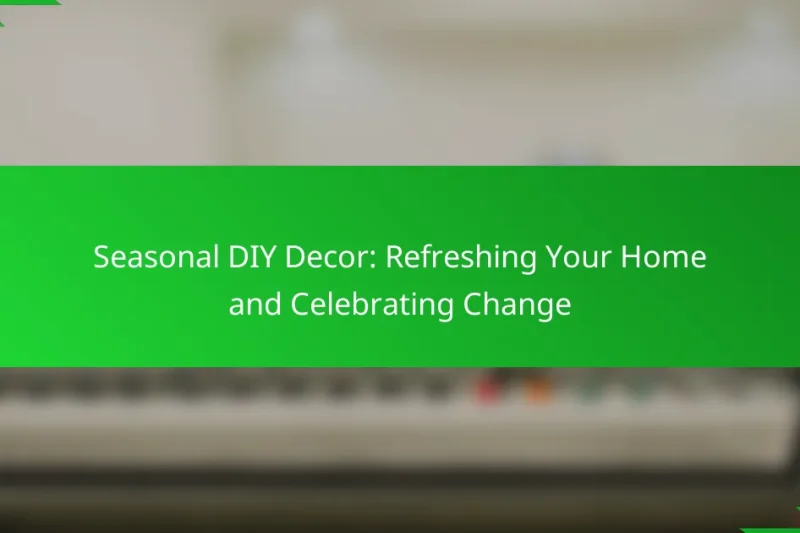Exploring trending color combinations can transform your living room, bedroom, and kitchen into stylish and inviting … Trending Color Combinations: Living Room, Bedroom and KitchenRead more
Discover the essential home decor products that can transform your space into a stylish and functional haven. This guide will help you navigate your choices by considering personal style, space limitations, and budget, while also highlighting the latest trends in sustainable and innovative design. Whether you're looking to enhance a small area or refresh your entire home, you'll find valuable insights to create a harmonious living environment.
Home Decor Trends: Budget-Friendly Strategies, Tips and Resources
Transforming your home on a budget is entirely possible with the latest trends that emphasize simplicity, … Home Decor Trends: Budget-Friendly Strategies, Tips and ResourcesRead more
Home Decor Products: Cozy Living Room Essentials
Transform your living room into a cozy retreat with essential decor items that promote warmth and … Home Decor Products: Cozy Living Room EssentialsRead more
Custom Decor: Craft Supplies, Local Stores and Unique Creations
Custom decor allows you to express your creativity through unique creations tailored to your personal style. … Custom Decor: Craft Supplies, Local Stores and Unique CreationsRead more
Seasonal DIY Decor: Refreshing Your Home and Celebrating Change
Seasonal DIY decor offers a wonderful opportunity to refresh your home and embrace the changing atmosphere … Seasonal DIY Decor: Refreshing Your Home and Celebrating ChangeRead more
Blending Decor Styles: Cohesion, Contrast, Color Harmony and Functionality
Blending decor styles can transform a space into a cohesive yet dynamic environment, where various design … Blending Decor Styles: Cohesion, Contrast, Color Harmony and FunctionalityRead more
Home Decor Products: Choosing the Right Lighting Fixtures
Choosing the right lighting fixtures is essential for enhancing both the aesthetic appeal and functionality of … Home Decor Products: Choosing the Right Lighting FixturesRead more
Rugs and Curtains: Choosing the Right Styles and Colors
Choosing the right rugs and curtains is essential for enhancing the aesthetic and functionality of your … Rugs and Curtains: Choosing the Right Styles and ColorsRead more
Accessories: Layering Textures, Creating Depth and Visual Interest
Layering textures in fashion is a powerful technique that adds depth and visual interest to any … Accessories: Layering Textures, Creating Depth and Visual InterestRead more
Seasonal Decor Styles: Winter, Spring, Summer, Fall
Seasonal decor styles provide a wonderful opportunity to refresh your living space and reflect the unique … Seasonal Decor Styles: Winter, Spring, Summer, FallRead more
What are the best home decor products for small spaces?
The best home decor products for small spaces maximize functionality while enhancing aesthetics. Key items include multi-functional furniture, wall-mounted shelves, compact storage solutions, decorative mirrors, and lightweight textiles.
Multi-functional furniture
Multi-functional furniture serves more than one purpose, making it ideal for small spaces. Consider a sofa bed that provides seating during the day and converts into a bed at night, or an ottoman that doubles as storage. These pieces help save space while maintaining style.
When selecting multi-functional furniture, look for items that fit your decor theme and have a practical design. For instance, a coffee table with built-in storage can keep your living area organized without sacrificing style.
Wall-mounted shelves
Wall-mounted shelves are excellent for utilizing vertical space in small rooms. They provide storage and display options without taking up floor space, making them perfect for books, plants, or decorative items. Choose shelves that complement your existing decor for a cohesive look.
When installing wall-mounted shelves, ensure they are securely anchored to support the weight of your items. Consider adjustable shelves to accommodate various sizes of decor and maximize versatility.
Compact storage solutions
Compact storage solutions help keep small spaces organized and clutter-free. Look for items like under-bed storage boxes, over-the-door organizers, or slim cabinets that fit in tight corners. These options can significantly enhance functionality without overwhelming the space.
Prioritize storage solutions that are easy to access and blend with your decor. For example, decorative baskets can provide stylish storage while keeping items out of sight.
Decorative mirrors
Decorative mirrors can create an illusion of space and light in small areas. By reflecting natural light and making a room feel larger, they are a practical addition to any small space. Choose mirrors with interesting frames to add a decorative touch.
Position mirrors strategically across from windows or light sources to maximize their effect. A large mirror can serve as a focal point while enhancing the overall ambiance of the room.
Lightweight textiles
Lightweight textiles, such as sheer curtains and soft throw blankets, can soften the look of small spaces without adding bulk. They allow light to filter through while providing a cozy atmosphere. Opt for fabrics in light colors to maintain an airy feel.
When selecting textiles, consider their ease of cleaning and maintenance. Lightweight materials are often easier to wash and dry, making them practical for everyday use in smaller homes.
How to choose home decor products?
Choosing home decor products involves understanding your personal style, evaluating your available space, setting a realistic budget, and researching materials. These steps help ensure that your selections enhance your living environment while reflecting your tastes and needs.
Consider your style
Your personal style is crucial when selecting home decor products. Identify whether your taste leans towards modern, traditional, rustic, or eclectic designs. This clarity will guide your choices and help create a cohesive look throughout your home.
Look for inspiration in magazines, online platforms, or showrooms. Create a mood board that captures colors, textures, and themes that resonate with you. This visual reference will streamline your decision-making process.
Assess your space
Evaluating your space is essential for selecting appropriate decor products. Measure the dimensions of your rooms to understand what fits comfortably without overcrowding. Consider the layout and flow of the space to ensure that your choices enhance functionality.
Think about the existing furniture and architectural features. Choose decor items that complement these elements rather than clash with them. For instance, if you have high ceilings, larger art pieces or tall plants can create a balanced look.
Set a budget
Establishing a budget helps you narrow down your options and avoid overspending. Determine how much you are willing to allocate for home decor, considering both individual items and overall costs. A budget range can be helpful, such as $500 to $1,500 for a room makeover.
Prioritize your purchases based on necessity and impact. Invest more in key pieces like sofas or dining tables, while opting for more affordable decor items like cushions or wall art. This strategy allows you to achieve a stylish look without breaking the bank.
Research materials
Understanding the materials used in home decor products is vital for durability and maintenance. Different materials offer varying levels of quality, aesthetics, and care requirements. For example, solid wood furniture tends to be more durable than particle board.
Consider the environmental impact of materials as well. Look for sustainable options like bamboo or reclaimed wood if eco-friendliness is a priority. Additionally, familiarize yourself with care instructions to ensure your decor remains in good condition over time.
What are the latest trends in home decor?
The latest trends in home decor focus on creating spaces that are not only aesthetically pleasing but also functional and sustainable. Key trends include biophilic design, the use of sustainable materials, bold colors and patterns, and smart home integration.
Biophilic design
Biophilic design emphasizes the connection between nature and interior spaces. This trend incorporates natural elements such as plants, natural light, and organic materials to enhance well-being and reduce stress.
To implement biophilic design, consider adding indoor plants, using natural wood finishes, and maximizing sunlight through large windows or skylights. This approach not only beautifies a space but also improves air quality and mood.
Sustainable materials
Sustainable materials are increasingly popular in home decor, driven by a growing awareness of environmental impact. Materials such as reclaimed wood, bamboo, and recycled metals are favored for their low ecological footprint.
When selecting sustainable materials, look for certifications like FSC (Forest Stewardship Council) for wood products or recycled content labels. This not only supports eco-friendly practices but can also add unique character to your home.
Bold colors and patterns
Bold colors and patterns are making a comeback, allowing homeowners to express their personality and creativity. Vibrant hues and striking designs can transform a dull space into a lively environment.
To incorporate bold colors, consider painting an accent wall or using patterned textiles for cushions and curtains. Aim for a balanced approach by pairing bold elements with neutral tones to avoid overwhelming the space.
Smart home integration
Smart home integration is revolutionizing how we interact with our living spaces. This trend involves using technology to control lighting, heating, and security systems through smartphones or voice commands.
When integrating smart home devices, prioritize compatibility and ease of use. Popular options include smart thermostats, lighting systems, and security cameras. Ensure that these devices are energy-efficient to maximize both convenience and sustainability.
How to decorate with home decor products?
Decorating with home decor products involves strategically selecting and arranging items to enhance your living space's aesthetic and functionality. Focus on elements like texture, color, and arrangement to create a cohesive and inviting environment.
Layering textures
Layering textures adds depth and interest to your decor. Combine materials such as wood, metal, fabric, and glass to create a rich sensory experience. For example, a soft wool throw on a leather sofa can create a warm and inviting contrast.
Consider using rugs, cushions, and curtains in varying textures to enhance comfort and visual appeal. Aim for a mix of smooth, rough, soft, and hard surfaces to keep the space dynamic and engaging.
Creating focal points
Creating focal points draws attention to specific areas in a room, making it feel more organized and visually appealing. This can be achieved through artwork, a statement piece of furniture, or an accent wall. Choose one or two key elements to serve as the center of interest.
For instance, a large painting above a fireplace or a bold-colored sofa can serve as a focal point. Ensure that surrounding decor complements rather than competes with the focal element to maintain harmony in the space.
Using color schemes
Using color schemes is essential for achieving a cohesive look in home decor. Select a primary color and one or two accent colors to create a balanced palette. Neutral tones can serve as a backdrop, while brighter colors can highlight specific features.
Consider using tools like color wheels to find complementary colors. A common approach is the 60-30-10 rule, where 60% of the room is a dominant color, 30% is a secondary color, and 10% is an accent color for accessories.
Arranging furniture
Arranging furniture effectively maximizes space and enhances functionality. Start by considering the room's purpose and flow; ensure there is enough space for movement and conversation. Group furniture into functional zones, such as seating areas or reading nooks.
Use the "floating" arrangement for larger rooms by placing furniture away from walls to create intimacy. Avoid overcrowding by leaving adequate space between pieces, typically around 18 inches for walkways, to maintain a comfortable atmosphere.
What are the best brands for home decor products?
The best brands for home decor products include IKEA, West Elm, and others that cater to various styles and budgets. Choosing the right brand depends on your aesthetic preferences, quality expectations, and price range.
IKEA for affordable options
IKEA is renowned for its budget-friendly home decor solutions, offering a wide range of furniture and accessories that are both stylish and functional. Their products often feature minimalist designs that appeal to a broad audience.
When shopping at IKEA, consider their ready-to-assemble furniture, which can save on shipping costs and allow for easy customization. Popular items include modular sofas, versatile shelving units, and decorative textiles, all typically priced in the low to mid-range.
West Elm for modern designs
West Elm specializes in modern and contemporary home decor, focusing on sustainable materials and unique designs. Their offerings often include chic furniture pieces, artisanal accessories, and stylish lighting options.
While West Elm products tend to be pricier than those at IKEA, they provide a higher-end aesthetic that can elevate your living space. Look for signature items like mid-century modern sofas or handcrafted decor to make a statement in your home.














